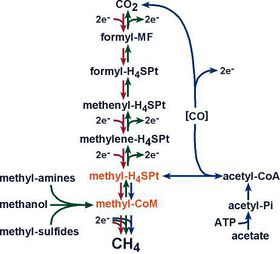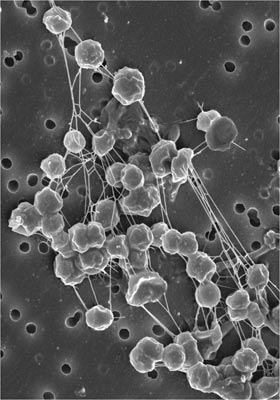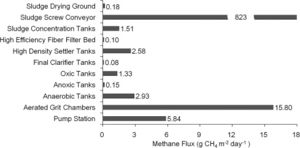The Role of Methanogens in Waste Water Treatment: Difference between revisions
Mooradianm (talk | contribs) |
Mooradianm (talk | contribs) |
||
| Line 4: | Line 4: | ||
==Methanogens== | ==Methanogens== | ||
<br>[[File: Methanogen_Classification.jpeg |thumb|300px|right|Classification of the different orders of Methanogens. Obtained from http://dc344.4shared.com/doc/U1tNMdLZ/preview.html]]<br> | <br>[[File: Methanogen_Classification.jpeg |thumb|300px|right|Figure 2: Classification of the different orders of Methanogens. Obtained from http://dc344.4shared.com/doc/U1tNMdLZ/preview.html]]<br>The methanogens are a group of Archaea within the euryachaeota order that perform methanogenesis (Figure 1). Methanogens are among the most diverse groups of microbes and differ significantly in their environmental conditions and cell structure. However, all methanogens require anaerobic environments, as the presence of oxygen blocks the process of methanogenesis from occurring (Slonczewski and Foster, 2014). There are over 50 described species of methanogens, which fall into five distinct orders (Figure 2). Methanogenesis can occur via six major reactions, each using different substrates. These different pathways help categorize the five orders of methanogenesis as well as determine the different environments each species is found in. The first order, the methanobacteriales, are rod shaped methanogens that utilize hydrogen and carbon dioxide in methanogenesis (Slonczewski and Foster, 2014). They are found at higher pH, ranging from 6 to 9, and a variety of temperatures. The second order, the methanococcales, are cocci which contain flagella and also utilize hydrogen and carbon dioxide (Slonczewski and Foster, 2014). The third order, the methanomicrobiales, utilizes acetate for methanogenesis (Slonczewski and Foster, 2014). This group is found at lower temperatures and can the cell shape varies from cocci to spirilla. The fourth order is the methanopyrales, a group of rod shaped methanogens that utilize carbon dioxide and hydrogen (Slonczewski and Foster, 2014). This group is found at extremely high temperatures. The final group is the methanosarcinales. This group is found in mostly low temperatures but has varying cell shape and methanogenesis substrates. They range from cocci to filamentous rods and metabolize almost every substrate used for methanogenesis (Slonczewski and Foster, 2014). The substrate used for methanogenesis also determines whether the species is a autotroph or a heterotroph. Those reducing carbon dioxide are considered autotrophs where as those utilizing other substrates are considered heterotrophs (Slonczewski and Foster, 2014). | ||
Although methanogens are highly diverse, they all contain certain key features. One of those features is the presence of a rigid cell wall (Slonczewski and Foster, 2014). This helps the cell maintain its distinctive shape, even in extreme environments. A second trait is their reliance on syntrophy. Syntrophy is the close association of an archaea with a bacterial partner in order to be provided with key substrates. Almost all methanogens participate in this practice in order to obtain the substrates used in methanogenesis. All methanogens must also be cultured in anaerobic chambers, due to the inability for methanogenesis to occur in the presence of oxygen. Finally, many methanogens are filamentous. This trait is especially useful in wastewater treatment because the bacterial partners necessary to provide the appropriate substrates get trapped within the filaments (Slonczewski and Foster, 2014). | |||
Methanogens are also found in a variety of different environments. The three most common habitats for microbes are soils, animal digestive tracts, and marine floor sediments. The soils of wetland systems are the most common and have received the most attention in the literature due to the methane emissions from wetland systems as well as their role as carbon sinks. Soil environments containing methanogens must be anaerobic, since methanogenesis cannot occur in the presence of oxygen. Due to this, wetland soils, which are usually anoxic, have some of the largest producers of methane where as drained soils often serve as methane sinks (Uggetti et al., 2012). The activity of methanogens and overall methane production from wetlands is therefore regulated by oxygen levels, water level, plant communities, and temperature (Uggetti et al., 2012). These varying factors mean than wetland systems can act as either methane sinks or sources depending on the rate of methane production and ability of the soils to sequester carbon. Landfills are also an important environment for methanogens. Landfills are rich in organic wastes, causing methane to build up within the system. Methane from these landfills must be pumped out in order to avoid explosions and can be collected and used for electricity (Slonczewski and Foster, 2014). Methanogens are also extremely common in the digestive tracts of animals, including termites, cattle, and humans. Methane emissions from agricultural cattle have increased significantly as industrial agriculture has taken over much of the country’s farming practices, which has contributed greatly to the overall greenhouse effect of methane. Methanogens in the human digestive tract account for 10% of all gut anaerobes and help increase the efficiency of digestion (Slonczewski and Foster, 2014). The final environment common for methanogens is in marine floor sediments. Methanogens at or beneath the seafloor form methane gas hydrates, which are methane molecules surrounded by water molecule cages (Slonczewski and Foster, 2014). These methane gas hydrates are a potential source of natural gas. | |||
==Methanogenesis== | ==Methanogenesis== | ||
Revision as of 01:24, 23 April 2014
Introduction
by Melissa Mooradian
As one of the most diverse groups of Archaea known to date, the Methanogens represent the euryarchaeota order which gains energy via methane production. The methanogens utilize the metabolic process of methanogenesis, which is the methane production pathway that converts carbon dioxide and other bacterial waste products into methane. Methanogens have become the focus of recent literature due to their large contribution to global methane emissions as well as their role in wastewater treatment. Methane is a potent greenhouse gas that has a global warming potential of 25 in a 100 year time frame and is estimated to account for 20% of the total radiative forcing from all greenhouse gases (Wang et al., 2011). The recent increase in methane emissions, from natural systems such as wetlands as well as landfills and agricultural cattle, has made the understanding of methanogens crucial to reducing the effects of climate change. Although methane emissions have negative environmental impacts, the use of methanogens can be crucial in reducing wastewater and the pollution of water systems across the world. Methanogens help break down organic material that would otherwise pollute water sources and lead to environmental degradation. The construction of wetland systems in developing countries has been adopted as a low cost and highly effective method of reducing nutrient concentrations and degrading organic compounds in agricultural as well as urban wastewaters (Johansson, et al., 2004). The balance of these two impacts is vitally important for the future.
Methanogens

The methanogens are a group of Archaea within the euryachaeota order that perform methanogenesis (Figure 1). Methanogens are among the most diverse groups of microbes and differ significantly in their environmental conditions and cell structure. However, all methanogens require anaerobic environments, as the presence of oxygen blocks the process of methanogenesis from occurring (Slonczewski and Foster, 2014). There are over 50 described species of methanogens, which fall into five distinct orders (Figure 2). Methanogenesis can occur via six major reactions, each using different substrates. These different pathways help categorize the five orders of methanogenesis as well as determine the different environments each species is found in. The first order, the methanobacteriales, are rod shaped methanogens that utilize hydrogen and carbon dioxide in methanogenesis (Slonczewski and Foster, 2014). They are found at higher pH, ranging from 6 to 9, and a variety of temperatures. The second order, the methanococcales, are cocci which contain flagella and also utilize hydrogen and carbon dioxide (Slonczewski and Foster, 2014). The third order, the methanomicrobiales, utilizes acetate for methanogenesis (Slonczewski and Foster, 2014). This group is found at lower temperatures and can the cell shape varies from cocci to spirilla. The fourth order is the methanopyrales, a group of rod shaped methanogens that utilize carbon dioxide and hydrogen (Slonczewski and Foster, 2014). This group is found at extremely high temperatures. The final group is the methanosarcinales. This group is found in mostly low temperatures but has varying cell shape and methanogenesis substrates. They range from cocci to filamentous rods and metabolize almost every substrate used for methanogenesis (Slonczewski and Foster, 2014). The substrate used for methanogenesis also determines whether the species is a autotroph or a heterotroph. Those reducing carbon dioxide are considered autotrophs where as those utilizing other substrates are considered heterotrophs (Slonczewski and Foster, 2014).
Although methanogens are highly diverse, they all contain certain key features. One of those features is the presence of a rigid cell wall (Slonczewski and Foster, 2014). This helps the cell maintain its distinctive shape, even in extreme environments. A second trait is their reliance on syntrophy. Syntrophy is the close association of an archaea with a bacterial partner in order to be provided with key substrates. Almost all methanogens participate in this practice in order to obtain the substrates used in methanogenesis. All methanogens must also be cultured in anaerobic chambers, due to the inability for methanogenesis to occur in the presence of oxygen. Finally, many methanogens are filamentous. This trait is especially useful in wastewater treatment because the bacterial partners necessary to provide the appropriate substrates get trapped within the filaments (Slonczewski and Foster, 2014). Methanogens are also found in a variety of different environments. The three most common habitats for microbes are soils, animal digestive tracts, and marine floor sediments. The soils of wetland systems are the most common and have received the most attention in the literature due to the methane emissions from wetland systems as well as their role as carbon sinks. Soil environments containing methanogens must be anaerobic, since methanogenesis cannot occur in the presence of oxygen. Due to this, wetland soils, which are usually anoxic, have some of the largest producers of methane where as drained soils often serve as methane sinks (Uggetti et al., 2012). The activity of methanogens and overall methane production from wetlands is therefore regulated by oxygen levels, water level, plant communities, and temperature (Uggetti et al., 2012). These varying factors mean than wetland systems can act as either methane sinks or sources depending on the rate of methane production and ability of the soils to sequester carbon. Landfills are also an important environment for methanogens. Landfills are rich in organic wastes, causing methane to build up within the system. Methane from these landfills must be pumped out in order to avoid explosions and can be collected and used for electricity (Slonczewski and Foster, 2014). Methanogens are also extremely common in the digestive tracts of animals, including termites, cattle, and humans. Methane emissions from agricultural cattle have increased significantly as industrial agriculture has taken over much of the country’s farming practices, which has contributed greatly to the overall greenhouse effect of methane. Methanogens in the human digestive tract account for 10% of all gut anaerobes and help increase the efficiency of digestion (Slonczewski and Foster, 2014). The final environment common for methanogens is in marine floor sediments. Methanogens at or beneath the seafloor form methane gas hydrates, which are methane molecules surrounded by water molecule cages (Slonczewski and Foster, 2014). These methane gas hydrates are a potential source of natural gas.
Methanogenesis

Uses in Wastewater Treatment
Possible Environmental Impacts
Include some current research in each topic, with at least one figure showing data.
Conclusion
Overall paper length should be 3,000 words, with at least 3 figures.
References
[8][Slonczewski, J.L., and Foster, J.W. "Microbiology: An Evolving Science". W.W. Norton and Company. 2014. Third Edition.]
Edited by student of Joan Slonczewski for BIOL 238 Microbiology, 2009, Kenyon College.



